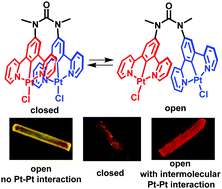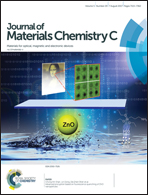Regulation of intra- and intermolecular Pt–Pt and π–π interactions of a U-shaped diplatinum complex to achieve pseudo-polymorphic emissions in solution and crystalline states†
Abstract
For the purpose of developing multicolor emissive molecular materials, a U-shaped diplatinum molecular switch 1 with an N,N-dimethylurea bridge was prepared. Three forms of single crystals of 1 with yellow (1A), orange (1B), or red (1C) emission were obtained. X-ray analysis shows that the two constituent [Pt(NCN)] units can have an open (1A and 1C) or closed (1B) conformation with different modes of crystal packing. In particular, intermolecular Pt–Pt interaction is evident for 1C with a short Pt–Pt distance of 3.226 Å. The interconversion among these crystals was triggered by external conditions, with the aid of an additional form of crystal 1D. The deep-red emissive crystal 1C exhibits excellent photophysical properties with λmax,emi of 650 nm, Φ of 36%, and τ of 846 ns. Spectroscopic analysis supports the hypothesis that compound 1 has a dominant open conformation in CHCl3 and a closed conformation in MeOH solution. The conformational switching and the degree of intermolecular interaction with tunable emission colors can be regulated by solvent composition.



 Please wait while we load your content...
Please wait while we load your content...